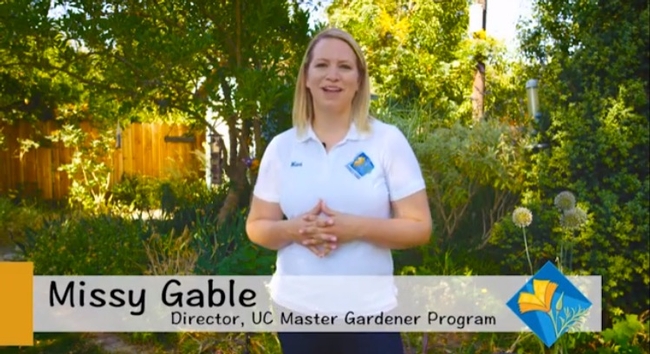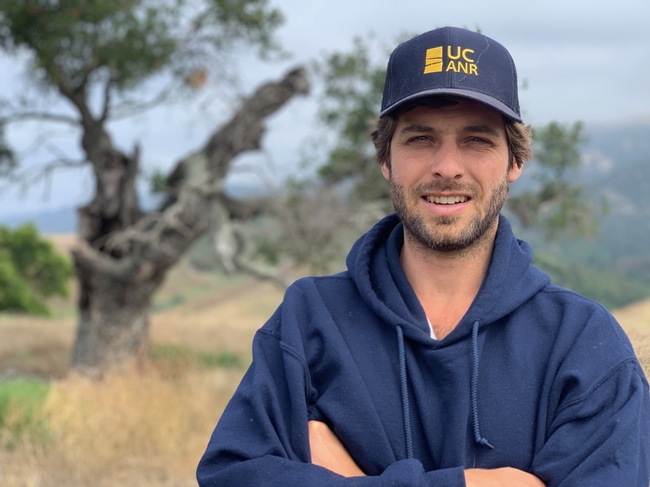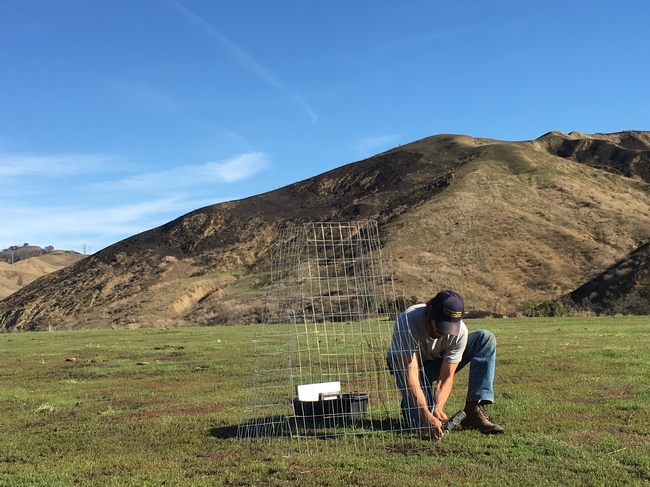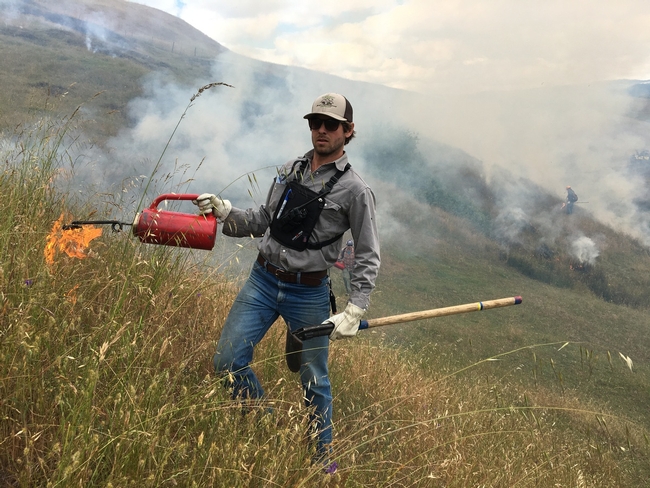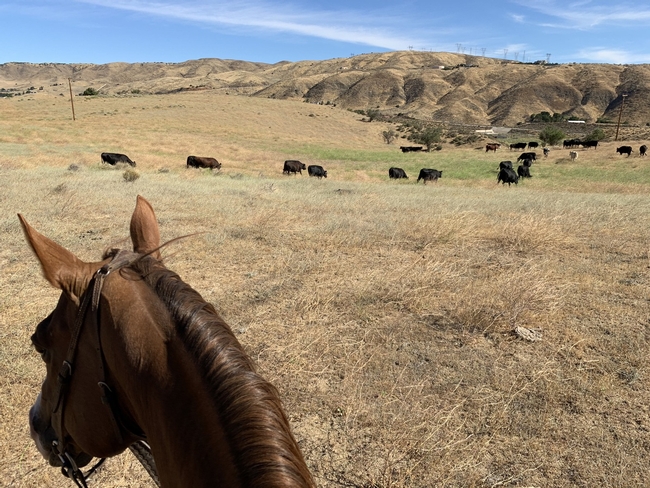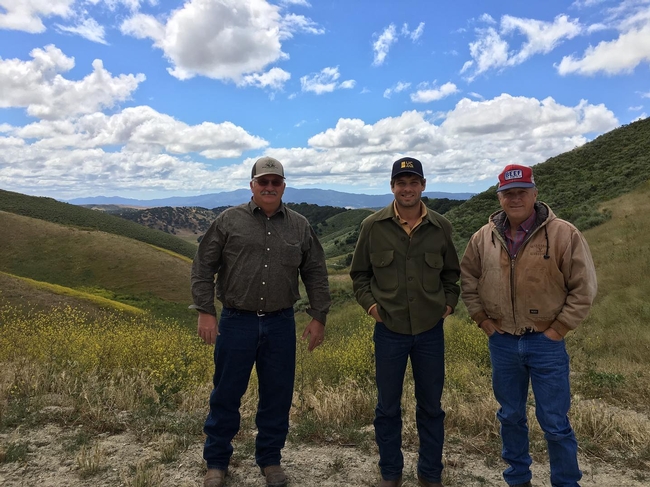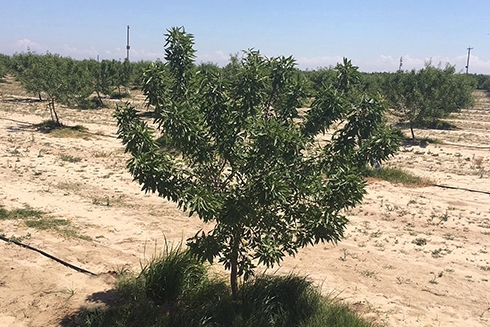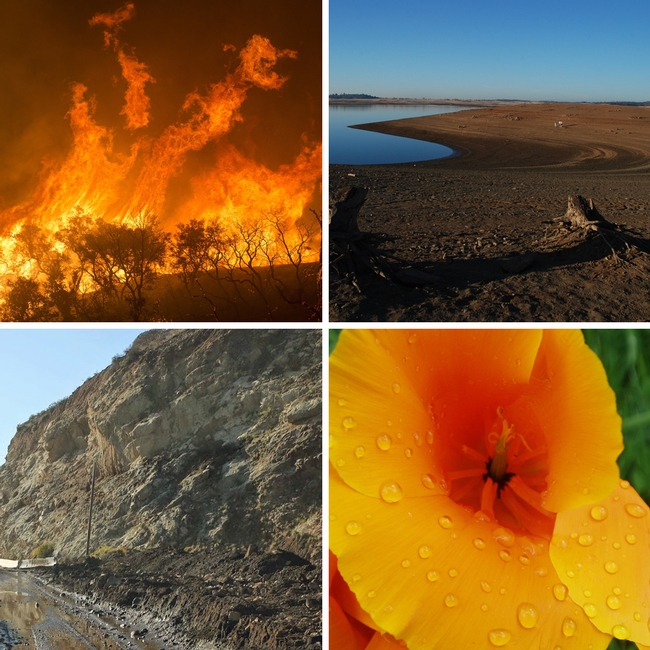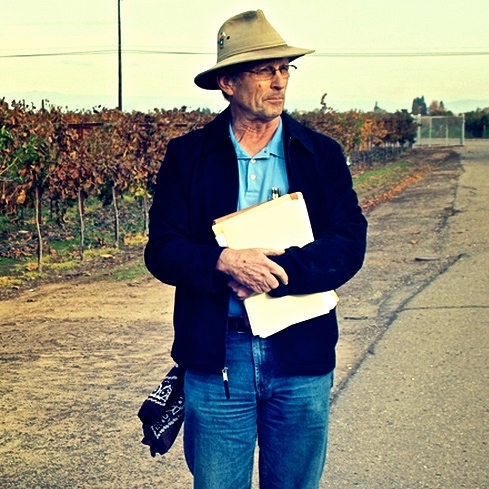Posts Tagged: Matthew Shapero
ANR in the news April 1-15, 2020
Pandemic And Wildfire: California Is Preparing For A Crisis Within A Crisis
(CapRadio) Ezra David Romero, April 15
…To protect human health, prescribed burns are not allowed for the time being on Forest Service land. But Ryan Tompkins, a forest advisor with the UC Cooperative Extension for Plumas, Sierra, and Lassen counties, says it's still early enough to prepare for wildfire with other tools like thinning and in some cases burning.
“It is really difficult because of the concerns about smoke and COVID, but sort of now is our chance to be prepared,” said Tompkins.
…“We know the agencies are going to have maybe limited capacity, limited resources, they're going to have other strains on their organizations while dealing with this crisis,” Tompkins said. “So, I think it emphasizes in a silver lining way that we all have a piece to play or a role to play.”
Susie Kocher, a forest adviser for the Lake Tahoe region with the UC Cooperative Extension, is concerned about a triple threat of COVID-19, wildfires, and power shutoffs.
“These two potential situations just could stack on top of the uncertainty of what people need to do,” she said.
Pandemic Crisis Got You Planting a Garden? Join the Club. (18:23)
(BYU Radio) April 14
Guest: Rose Hayden-Smith, PhD, Kellogg Food and Society Policy Fellow, Emeritus Professor of Agriculture and Natural Resources for the University of California, Author of "Sowing the Seeds of Victory: American Gardening Programs of WWI"
The pandemic has sparked a moment of “crisis gardening” among Americans. It's not much different from the Victory Gardens that sprung up in yards around the country during World War I, and then again in World War II.
New fungicide approved for Calif. tree nuts
(Farm Press) Tim Hearden, April 14
… University of California, Riverside plant pathologist Jim Adaskaveg helped develop data to validate the efficacy of ManKocide for California tree nuts and says the product has advantages, including ease of use.
It is also highly effective against copper-resistant bacteria in California, Adaskaveg said in an email.
“The product has efficacy against the walnut blight and bacterial spot of almond pathogens and suppresses fire blight on pome fruit and bacterial blast on almond,” he said.
Adaskaveg said he is unaware of other products that have this combination as a premixture,
https://www.farmprogress.com/tree-nuts/new-fungicide-approved-calif-tree-nuts
People are rushing to plant 'pandemic gardens' and seed companies say they can't keep up with the surge in demand
(Business Insider) Michelle Mark, April 14, 2020
…It's not the first time economic crises have led Americans to grow their own food. One food historian told HuffPost that the trend began during WWI and WWII.
"Crisis-gardening is not new," Rose Hayden-Smith, the author of "Sowing the Seeds of Victory," told the outlet.
https://www.insider.com/seed-companies-cant-keep-up-with-demand-for-pandemic-gardens-2020-4
4-H searches for locals to serve on sponsoring committee
(San Benito Link) Devii Rao, April 14
We are looking for a few local people to serve on a sponsoring committee to keep 4-H active and strong in San Benito County. The sponsoring committee will organize events such as letter writing campaigns, barn dances, dinners, silent and live auctions, fireworks booths, having 4-H youth sell treats at the fair, or your other creative ideas! Sponsoring committee members are not required to have any affiliation with 4-H. We are looking for business leaders and other people who are well connected in the community and who are motivated to provide educational and leadership opportunities to our youth.
https://benitolink.com/4-h-searches-for-locals-to-serve-on-sponsoring-committee/
California dairies dump milk, crops may be left to wither as coronavirus pandemic disrupts food system
(SF Chronicle) Kurtis Alexander, April 12
…“Everybody's scrambling. The whole food system is scrambling,” said Daniel Sumner, an agricultural economist at UC Davis. “I don't see a big supply-side issue for agriculture. It's really an issue with the food (delivery) system.”
https://www.sfchronicle.com/news/article/California-dairies-dump-milk-crops-may-be-left-15195891.php
Widespread shutdown order slams California dairy farmers, ‘You can't turn off the cows'
(Sacramento Bee) Michael Finch II, April 10
…“Like every part of the food system, there are complications. The issue for milk is you can't turn off the cows,” said Daniel A. Sumner, an agricultural economist and professor at UC Davis. “What's becoming more of a problem is the slightly longer-term outlook where we have a massive recession (coming).”
Dairy prices are regulated by the federal government and fluctuate on the Chicago Mercantile Exchange. So the price of large quantities of milk, cheese, whey and milk powder is set based on data from the prior month, Sumner said.
In January, milk traded at nearly 18 cents per pound and by March the amount fell nearly five cents. Sumner said this suggests there is a price shock to come in the summer.
https://www.sacbee.com/news/california/article241896861.html
Grocers Serving Low-Income Neighborhoods Pinched by Shortages, Rising Prices
(KQED) Farida Jhabvala Romero, April 10
…“This hoarding behavior is unfortunate,” said Richard Sexton, a professor of agriculture and resource economics at UC Davis. “We can understand why people do it, but it is what's causing these disruptions.”
… The current shortages could deepen disadvantages for family-owned neighborhood stores, said Sexton, the UC Davis economist.
“The little guys, the small chains of just a few stores, could get the short end of the stick in this situation because food manufacturers and distributors are going to probably prioritize their biggest and best customers,” he said.
Private Grant Will Support New UC California Organic Institute
(Organic Farmer) Marni Katz, April 10
A $1 million endowment will establish the University of California's first institute for organic research and education within the UC's Agriculture and Natural Resources division (UC ANR), expanding the UC Cooperative Extension's research and outreach capacity to target organic growers in California.
http://organicfarmermag.com/2020/04/private-grant-will-support-new-uc-california-organic-institute/
UCANR points to help for Californians amid crisis
(Farm Press) Mark Bell, April 10
…In response to these pressing needs, UC Agriculture and Natural Resources, like many other universities and extension organizations across the country, are moving quickly to get more information online. While I haven't seen the actual numbers, we know millions of students (both high school and university) are quickly transitioning to online classes.
https://www.farmprogress.com/extension/ucanr-points-help-californians-amid-crisis
Scientists Worry Agency Plan to Prevent Fires Could Do Opposite
(Bloomberg) Bobby Magill, April 9
…Controlling wildfire in the region depends on how many firefighters the federal government has on the ground—and they'd have to be in the right place at the right time for the fuels reduction plan to work, said Max Moritz, a wildfire specialist at the University of California, Santa Barbara studying how wildfire affects broad landscapes.
As the climate changes, the effectiveness of fuels reductions projects and fuel breaks begins to fade, he said.
“Climate change seems to be priming the landscape for fires to ignite more easily, spread more easily, to burn hotter and larger—so all of these aspects of climate change would make one suspect that fuel breaks have a harder and harder time doing their job,” Moritz said.
The wildfire program is an “expensive large-scale experiment,” he said.
The real reason we're seeing more wildlife during the pandemic
(Pop Sci) Ula Chrobak, April 9
…In those cases, additional sightings might be due to simple behavior changes. But a less charismatic creature may be also on the rise due to an increased human presence at home. Niamh Quinn, a human-wildlife interactions advisor with the University of California, thinks that rat populations may be increasing in New Orleans and elsewhere. That's because people are cooking, storing, and disposing of at home, drawing rats away from closed restaurants and toward residences.
…Quinn agrees. Late last year, she radio-collared five coyotes in Los Angeles for a research project. She says that her coyotes haven't changed their routines since the shelter-in-place order went into effect, staying in their respective territories, which include areas near a shopping mall and golf course. Quinn adds that while the number of coyotes reported in San Francisco on the Coyote Cacher website isn't unusual, they could be moving about during the day more. “People are just at home noticing more things,” she says. “Especially in California, we're not all spending five hours a day on the freeway [now], you know?”
https://www.popsci.com/story/environment/wildlife-in-cities-covid-shutdown
HLB spreads slowly, confined to residential citrus
(Capital Press) Padma Naggapan, April 9
…”It's slower than we expected, compared to Texas and Florida,” said Elizabeth Grafton-Cardwell. “In the Central Valley, homeowners and growers have been able to eradicate the pest, although it's been much more challenging in Southern California. But growers are doing an outstanding job of controlling the psyllids.”
Almond Update: Maximizing Yields and Sustainability from Start to Finish
(AgNet West) Taylor Hillman, April 9, 2020
Setting an orchard up for maximum yield and sustainability is a long game for producers. There are lots of variables, and some are unpredictable such as mother nature. But UC Cooperative Extension Tree Crop Advisor Franz Niederholzer said growers can do several things in the life of an orchard to stay in the game. He believes the most sustainable plan in every aspect of growing is to not focus on hitting home runs but instead have constant attention on management to help them avoid making outs.
http://agnetwest.com/almond-update-maximizing-yields-and-sustainability-from-start-to-finish/
Soil health practices show benefits
(Morning Ag Clips) Jeannette Warnert, April 9, 2020
A group of California organic farmers is sharing information about their efforts to combine reduced tillage with the use of cover crops, which they have been planting on their vegetable farms for decades to protect soil while adding carbon and diversity to their production systems.
“Every one of the pioneering farmers has seen tremendous benefits from the practices,” said Jeff Mitchell, UC Cooperative Extension vegetable crops specialist. “These are the very growing practices that we have demonstrated over two decades of research to benefit soil health, environmental conservation and the bottom line on plots near Five Points in Fresno County.”
https://www.morningagclips.com/soil-health-practices-show-benefits/
Why are eggs getting so expensive? Blame coronavirus demand
(LA Times) Samantha Masunaga, April 8
…“Eggs are naturally, very often, one of the most price variable products in the supermarket,” said Daniel Sumner, UC Davis professor of agricultural economics and director of the UC Agricultural Issues Center.
…Egg prices could remain elevated for at least a few months, Sumner said. And the demand for eggs has been historically strong during tougher economic stretches. Eggs are a relatively cheap source of protein and aren't seen as a luxury food item.
“It may take longer to get back to normal for the egg business,” he said. “We can build supply, but it takes a few months.”
https://www.latimes.com/business/story/2020-04-08/egg-prices-rising-coronavirus
Rock Front Ranch permanently conserved for wildlife, grazing by Rangeland Trust
(Santa Maria Times) April 7
“To have this ranch be up against and abut to tens of thousands of acres of public lands is an indispensable connection to have in perpetuity,” said Matthew Shapero, livestock and range adviser in Santa Barbara and Ventura Counties for the University of California Cooperative Extension.
Nutrition experts fear 'dirty dozen' produce list will put off consumers
(UPI) Jessie Higgins, April 7
…"Our typical exposure to pesticides is far lower than levels of health concern," Carl Winter, an emeritus cooperative extension specialist in food and science technology at the University of California-Davis, said in an email.
"A graduate student and I published a paper in 2011 relating dietary exposure to toxicity for the 10 most frequently detected pesticides found on the EWG's 2010 Dirty Dozen list," he said. "Estimated exposures were far below levels of toxicological concern. Recommending consumers reduce their consumption of conventional fruits and vegetables on the Dirty Dozen list is unwarranted."
How to grow a vegetable garden, according to legendary chef Alice Waters
(Fast Company) Aimee Rawlins, April 7
… It's natural to want to go big and plant everything. But it's important to be realistic and start small, and not just because the productivity trap can be debilitating at a time like this.
“Right now we have enough on our plate. Start modestly and in a way that you can manage it,” says Missy Gable, director of the University of California's Master Gardener Program. “If you've never done this before, don't transform a quarter acre.”
… Because soil quality and composition varies depending on region and location, Gable recommends looking up your local master gardener extension program. These programs, which exist in all 50 states, offer classes and resources for home gardeners as well as knowledgable volunteers who are plugged in to local climate and soil particulars. Right now, some master gardener programs, like the one at Oregon State University, are also offering virtual classes. (OSU waived its fee for April and already has more than 17,000 participants.)
Pistachio Rootstock Options Today: Seedlings and Clones
(Pacific Nut Producer) Matthew Malcolm, April 6
Pistachio growers have more options today when it comes to varieties and rootstocks to plant with. Watch this brief interview with UCCE Farm Advisor Elizabeth Fichtner as she shares some of the characteristics of rootstocks currently available to growers and some of the pros and cons to planting on a seedling vs. clone. Read more in Pacific Nut Producer Magazine.
https://pacificnutproducer.com/2020/04/06/pistachio-rootstock-options-today-seedlings-and-clones/
UC urges cattle producers to take precautions
(Farm Press) Larry Forero, Sheila Barry, Josh Davy, Gabrielle Maier, April 6
The COVID-19 pandemic has much of the California population staying home in an effort to reduce the spread of the virus. Across the state, many grocery stores have had shelves emptied of food and other day-to-day necessities as people have stockpiled these essentials.
https://www.farmprogress.com/livestock/uc-urges-cattle-producers-take-precautions
http://agnetwest.com/spring-cattle-work-calls-for-covid-19-precautions/
Coronavirus hit California's cut-flower industry at the worst time
((LA Times) Geoffrey Mohan, April 4
…Cut flowers are a $1.3-billion industry nationwide, though most of that revenue comes from the sale of imported flowers, predominantly from Colombia, according to the UC Davis Agricultural Issues Center. Domestic growers account for about 27% of national sales, down from 37% roughly a decade ago. California-grown flowers account for three-quarters of the national domestic sales, according to the UC Davis researchers.
https://www.latimes.com/business/story/2020-04-04/coronavirus-californias-cut-flower-industry
How The Coronavirus Pandemic Has Led To A Boom In Crisis Gardening
(Huff Post) Jodi Helmer, April 3
… Even though food supplies may be currently secure, said Rose Hayden-Smith, a food historian and author of “Sowing the Seeds of Victory,” understocked supermarket shelves are forcing shoppers to think about the source of their food, especially fruits and vegetables, often for the first time. And their fears have led them straight to the garden center.
“It's helpful to be productive and connect with nature and it's something that's within our control in a situation that feels entirely out of control,” she said.
https://www.huffpost.com/entry/seeds-crisis-gardening-coronavirus-food_n_5e85eca0c5b6f55ebf492212
Gardening during a pandemic
(Appeal Democrat) Chris Kaufman, April 3
Since the toilet paper panic-buying subsided, another item quietly flew off the shelves: garden seeds.
Springtime weather combined with shelter-in-place orders and empty shelves at stores has spurred a spike in seed sales, according to some gardening experts.
“I've seen an increase in seed sales because I've been looking around to see what people are doing and anticipating what kind of questions we will get once we open up again,” said Jan Kendel, a master gardener with the Sutter-Yuba University of California Cooperative Extension. “We've had some calls and emails from people wanting to know if it's a good time to plant tomatoes.”
Spotted Lanternfly is an Invasive Pest
(AgInfo) Tim Hammerich, April 2
The spotted lanternfly is a colorful insect pest that has been infesting vineyards and orchards in the eastern U.S. So far, we have been effective in our efforts to keep the pest away from California's multi-billion-dollar ag industry. But we must remain diligent in these efforts, says Dr. Surendra Dara, Entomology and Biologicals Advisor in San Luis Obispo and Santa Barbara Counties.
“Spotted lanternfly is an invasive pest because of the reason we don't have any natural enemies that can suppress their populations in a natural way in a new environment," said Dara. "And it can actually infest grapes and several other hosts in California of commercial importance. So it is important for us to be aware of the potential impact and do the need to prevent the damage."
https://californiaagtoday.com/keeping-spotted-lanterfly-state/
The Moment for Food Sovereignty is Now
(Civil Eats) Katie Brimm, April 2
… “People are thinking, ‘If I can't get toilet paper, am I going to be able to get food?'” said Rose Hayden-Smith, a longtime community gardener and a Victory Garden historian, who recently retired from the University of California.
… Hayden-Smith notes that, despite the fact that the coronavirus pandemic came on much more suddenly than either World War, individuals and communities are once again turning to gardening to create food security.
https://civileats.com/2020/04/02/the-moment-for-food-sovereignty-is-now/
California's truffle industry could be poised for growth if top hunter helps find path
(Sac Bee) Becky Grunewald, April 1
… Her dining companion is a tall scientist with a gentle demeanor, Scott Oneto. Although he didn't command the attention of this room, his work could be key to whether truffle cultivation becomes big business in local farming, or just a flash in the (frying) pan.
Oneto, a sixth generation California farmer with a background in weed science, had to be coaxed into the project, according to O'Toole. Oneto said after a few years of requests, it took a much-needed sabbatical, at which he could “really dive into research” to catch him at the perfect point to start their (hopefully) fruitful collaboration.
An Aggie through-and-through, Oneto got both his bachelor's and master's degrees at UC Davis, and works for Agriculture and Natural Resources. ANR is an unsung arm of the University of California, with the mission to bring the latest in agricultural science to the California community. Oneto not only bridges the gap to farmers by translating academic science research into in-person workshops and handouts, he also tailors research to local needs.
“When I have a farmer or rancher who is presented with problems, whether it be a new pest, weed, pathogen, or the effects of climate change, we help them solve those problems so they can continue to be successful in agriculture,” Oneto said.
https://www.sacbee.com/news/business/article241680801.html
Humboldt Using Satellite Tech Against Illicit Cannabis
(TechWire) Carl Smith, April 1
…“Local zoning, permitting and enforcement is probably more important than state-level initiatives, although collaboration across units of government is also key,” said Van Butsic, co-director of the Cannabis Research Center at the University of California, Berkeley.
In fact, every available strategy is needed as California works to implement the “robust standards” that it envisions for cannabis cultivation. For one thing, growers who are willing to play by the rules still face competition from illicit operations. In 2019, sales of illegal cannabis products in California were expected to hit $8.7 billion, more than twice the total for legal sales.
“Larger producers have been able to navigate the system,” said Butsic. “Many smaller growers are going out of business or staying illegal.” Costs are also part of the equation. “The illegal market is competitive because legal marijuana is so expensive to produce under Prop. 64,” Dale Gieringer, director of Cal NORML, told The Los Angeles Times.
https://www.techwire.net/news/humboldt-using-satellite-tech-against-illicit-cannabis.html
GMOs Are an Ally in a Changing Climate
(Wired) Emma Marris, April 1, 2020
In Davis, California, 190 miles from Terranova, I met up with Pamela Ronald, a plant geneticist at UC Davis who has worked to solve this problem. Climate change is making floods worse in parts of South Asia, and in 2006, Ronald helped create a kind of rice that can survive submersion in water. By 2017, some 6 million farmers in Bangladesh, Nepal, and India were growing this rice. We talked in her cozy office, where a painting hangs on the wall of a man under a deluge of rain struggling to plow a field.
https://www.wired.com/story/future-food-will-need-gmo-organic-hybrid/
College farms still functioning amid shutdowns
(Farm Press) Tim Hearden, April 1, 2020
…Most employees for the UC's Division of Agriculture and Natural Resources are working remotely during their normal business hours and visiting sites in person for essential duties such as feeding animals, officials said. All the UC Cooperative Extension's in-person seminars and workshops scheduled for April were cancelled.
At the research centers, UC leaders are considering which projects should continue and which ones could be postponed, said Mark Lagrimini, UCANR's vice provost of research and extension.
“With the research that can go forward, we're making sure that protection is provided for the workers and students,”Lagrimini said. “We do have staff out there working right now. We have over 500 projects going on. We're in the process of going through 500 projects and making sure they are all able to be conducted safely. It's a big job.
https://www.farmprogress.com/farm-operations/college-farms-still-functioning-amid-shutdowns
Shapero protecting California’s natural resources
Rose Hayden-Smith, UC Cooperative Extension digital communications in food systems & extension educator, talked with Matthew Shapero about his work protecting California's natural resources. This is the second in a series featuring a few scientists whose work exemplifies UC ANR's public value for California.
Matthew Shapero is originally from California and has worked as an ANR Cooperative Extension livestock and range advisor since September 2017, based in Santa Barbara and Ventura counties. Matthew attended Columbia University and completed a Master of Science in range management from UC Berkeley. Prior to joining ANR, he farmed on the East Coast and in Nevada County, where he ran a ranch. His current research and Extension program focuses on several issues, including prescribed fire and how to prepare for and respond to wildfire. You can follow Matthew on Facebook and Instagram.
Tell us about your current research and Extension projects
I could certainly use the old ranching metaphor: “Way too many irons in the fire.” As a beginning advisor, one says “yes” to things that seem interesting and have promise, but projects develop in their own time. I'm currently working a great deal on wildfire issues, including prescribed fire and fire recovery. There's a need for long-term research to look at the effects of grazing as part of post-fire recovery. I am working with five ranches that experienced fire, and considering how land managers and agencies might be thinking about grazing and post wildfire recovery.
I'm also doing some research on soil seed bank, with a focus on how fire intensity impacts rangeland seed bank. [Editor's Note: “Soil seed bank” refers to the natural storage of seeds – often dormant – within the soil of ecosystems.]
Has thinking evolved on prescribed fire?
It has. I received an M.S. degree in range management from UC Berkeley. The program didn't cover much of the research and practices around prescribed fire, because it seemed to be an unrealistic land management tool in today's day and age. The Thomas fire occurred in December 2017, just three months after I started my work as a Cooperative Extension advisor. I've seen the political winds shift since then; prescribed fire has become much more palatable in this area since Thomas, as a technique to proactively deal with the threat of catastrophic wildfire.
There's a relatively short window (a couple of months annually) where the conditions and circumstances are aligned for prescribed burning. In Fall 2018, I was involved in a prescribed burn of 380 acres using a type of private burn permitting that hadn't been used in a long time. As a Cooperative Extension advisor, I played a relatively important role in connecting the dots and helping that burn get up and off the ground. Part of my work is nudging people, following up, connecting people. I think my work is a good example of how a Cooperative Extension advisor inserts himself/herself into the process. With ranchers, private landowners, county fire agencies and others involved, there is a need for good communication.
In the aftermath of that burn, I organized an event for elected officials, agency heads, and other decision makers to visit the prescribed burn site. It was helpful for them.
My program covers Ventura and Santa Barbara counties, which have different histories with prescribed fire. Santa Barbara County has had a strong range improvement association from the 1950s through the present, which conducted prescribed burns at a significant rate up through the 1990s. For example, between 1955 and 1964, this association burned over 100,000 acres in private land, with little assistance from the county fire department.
This is in contrast to Ventura County, which has less of a surviving rancher-led burn culture. While producers burned within the county, there is no formal existing organization that plans and executes burns. I've been helping to revive burn culture in Santa Barbara County, but there's been less to draw on in Ventura County. Both have county fire agencies instead of CalFIRE. They are supportive of private-led burning, but to actually implement prescribed burns is easier in Santa Barbara County than in Ventura County. Ranchers and private landowners in Santa Barbara are more comfortable with fire, and many have some of the resources required (water tending trucks, drip torches, flamethrowers, etc.). We're building momentum, though, and the conversation has shifted since the Thomas Fire.
Did the Thomas Fire change perceptions about the value of ranchland in Southern California?
The Thomas Fire demonstrated that even if you live in a city or suburb, the way natural resources are managed impacts you. Livestock production is not an agricultural sector that generates a lot of gross revenue (it barely registers in the list of top 10 crops by revenue in each county), but it has great spatial impact. How it is managed impacts water quality, wildlife habitat, and the view those living on the peri-urban interface enjoy. There is important public and economic value in the way rangelands are managed.
What are the challenges facing the ranching industry in Southern California?
The challenges the ranching industry faces in Southern California aren't necessarily new. I recently came across an Extension research bulletin published in 1972 that explained how Santa Barbara County was trialing new nitrogen fertilizer on rangeland. My predecessors identified “rising taxes and land scarcity” as challenges facing ranchers, and these things would still hold true.
These challenges are not unique in California, but the impact may feel different here. The Southern California counties in particular have a long and deep ranching history that was defined in many ways by Spanish ranchos.
The industry is potentially at a critical breaking point, though. It's not just land, but the lack of supporting infrastructure. For example, it's much more difficult to get cattle trucks down here; the nearest approved USDA slaughter house is hours away, and the nearest sale yard is in Kern or Monterey County. In Santa Barbara County, there is increasing pressure for land conversion and land use change. Many individuals are interested in creating vineyards and estates, which is breaking up and making into smaller parcels larger ranches, so that they can no longer be run profitably as livestock operations.
In an optimistic sense, there has been a shift in public opinion over the last 20 years about ranching. At one time, ranching was vilified as being harmful to land, especially public lands. The Bay Area has had more sophisticated conversations about how ranching and environmentalism can co-exist, and what the co-benefits are.
There is every reason to think that the conversation around ranching will mature and become more nuanced in Southern California as well. Topics such as water quality and endangered species - which seemed like flashpoints and a source of friction – have given way to discussions that identify areas of co-benefit. Ranchers do so much for wildlife in keeping rangelands open and undeveloped. But they are often targeted with what they regard as unfair legislation around fencing and vegetation removal. Urban public opinion should recognize the value of keeping ranchers on the land.
Why are you working for Cooperative Extension?
I'm interested in the public value aspects of the work. Traditionally, Cooperative Extension measured the impact of our work by the increase of forage grown per acre, or the number of pounds of beef extracted from a ranch. While those things are important, I see our role expanding. In addition to increasing agricultural production, my work is also about the potential to engage on policy and on a cultural level.
Livestock advisors throughout the state are an important point of nexus in terms of communicating the value of ecosystems management. We are often the connection between the broader general public and an agricultural constituency. I spend a lot of my time translating how and why ranching benefits the general public, why cattle might be good for the planet (not bad), and why cattle have ecosystem benefits for rangelands. I find as much as my work is increasing and improving herd health, it is also lubricating public policy discussions, and providing analysis that has benefits for ranchers and the general public.
Extension grounds positions in science and through neutrality. There is an important role for Extension in facilitating the conversations that identify mutual benefits.
February 2019 news clips
Above average rainfall in February benefits strawberry crops in the Central Valley
(ABC 30) Reuben Contreras, Feb. 28
…Above average rainfall in February will help this year's harvest last through October.
"It looks like it is in full bloom right now and it looks like it is going to rain. So we need the water as much as we can right now," said Michael Yang, University of California Cooperative Extension.
He works with small farms and specialty crops in the Hmong community, including a strawberry field in Northeast Fresno near Willow and Behymer.
Yang said the rain will add to the groundwater supply most farmers use to grow their crops plus it will help make the strawberries sweeter.
Ventura County Helps Keep Farming Alive in Southern California
(KCET) Teresa O'Connor, Feb. 27
…Connecting the community to the food system is vitally important for the health of individuals and the survival of local farms, according to Rose Hayden-Smith, Ph.D., who is the editor of the UCFoodObserver.com, an online publication for the University of California (UC). A long-term county resident, Hayden-Smith was previously sustainable food systems initiative leader for UC's Ag and Natural Resources division.
“Everyone eats: everyone is a stakeholder,” says Hayden-Smith. “I would like people to be engaged with the food system, and to advocate for positive change. Think about where your food comes from and ask critical questions about the supply chain. Meet people who are involved in producing, processing, distributing and preparing the food you eat. Honor them with questions about and interest in their work.”
Gene-edited animal creators look beyond US market
(Nature) Heidi Ledford, Feb. 20
…It isn't always easy to pick up a research project and move it to a different country. About ten years ago, difficulties finding funding for his research drove animal geneticist James Murray to move his transgenic goat project from the University of California in Davis to Brazil. The goats were engineered to produce milk that contained lysozyme, an enzyme with antibiotic properties. Murray hoped that the milk could help to protect children from diarrhoea.
https://www.nature.com/articles/d41586-019-00600-4
Newly discovered nematode threatens key crops
(Farm Press) Logan Hawkes, Feb. 20
“The arrival of this nematode (Meloidogyne floridensis) in California is a little surprising — it has the potential to infect many of California's economically important crops,” says UCCE Kern County Advisor Mohammad Yaghmour. “Root samples had been collected from an almond orchard in Merced County last year, and confirmed at the California Department of Food and Agriculture's (CDFA) Nematology Lab as M. floridensis.”
Yaghmour facilitated the second discovery of the nematode in a Kern County orchard a month after the first was uncovered in an almond orchard in Merced County.
https://www.farmprogress.com/tree-nuts/newly-discovered-nematode-threatens-key-crops
Ag Innovations Conference and Trade Show returning to Santa Maria for third event
(Santa Ynez Valley News) Mike Hodgson, Feb. 19
The Ag Innovations Conference and Trade Show will return to Santa Maria for its third event, this time focusing on biologicals, on March 5. The deadline for discounted early registration is next week.
… Considering the growing interest in biologicals and the demand for sustainably produced food, organizers selected topics on biocontrol agents, biostimulants and botanical and microbial pesticides and fungicides for the third conference, said organizer Surendra Dara, UC Cooperative Extension adviser for entomology and biologicals.
“The use of biocontrol agents, biopesticides, biostimulants and other such tools is gradually increasing in our efforts to produce with sustainable practices,” Dara said.
Almond Update: Orchard Recycling Research Showing Strong Results
(AgNet West) Taylor Hillman, Feb. 14
Orchard recycling research has been going on for over 10 years. UC Cooperative Extension Advisor Brent Holtz has been leading the project and said they continue to see positive results. There is an expense that comes with the practice but Holtz said their longest trial is making that cost back in added production.
http://agnetwest.com/almond-update-orchard-recycling-research
NASA tech helps agriculture
(Hanford Sentinel) Julissa Zavala, Feb 13,
…In keeping with the expo's theme, “Harvesting Technology,” NASA Administrator Jim Bridenstine visited the International Agri-Center in Tulare and spoke about how technology originally developed for space exploration is now being repurposed and used to improve numerous aspects of agriculture around the world.
…The measurement, also taken with LIDAR, can be used to calculate precise irrigation needs of plants and crops. Bridenstine said this pilot program, in partnership with the University of California Cooperative Extension and other agencies, is only being used in California.
UC Davis, wine industry cultivate relationship
(Fruit Growers News) Robin Derieux, Feb. 13
Under the hot summer sun of the San Joaquin Valley, just south of Merced, Miguel Guerrero of The Wine Group is trying a new high-wire act. In collaboration with University of California-Davis Cooperative Extension, Roduner Ranch vineyard manager Guerrero is experimenting with Cabernet Sauvignon vines and other varieties elevated by a single wire at 66 inches – plantings that are 2-3 feet higher than the traditional winegrape canopy.
…“The beauty of the high-wire system is that the fruit zone is really defined – a solid wall of grape clusters – and the pruning machine can just zip right alongside the vines,” said Kaan Kurtural, a UC Davis Cooperative Extension viticulture specialist. “We can carry more crop, and with mechanical leaf removal, we get that sun-dappled exposure that feeds the fruit. Less leaf cover means the vines require less water, and the grape quality is much better.”
https://fruitgrowersnews.com/article/uc-davis-wine-industry-cultivate-relationship
There's Still So Much We Need To Learn About Weed—And Fast
(Wired) Matt Simon, Feb. 11
… But late last month, UC Berkeley opened the Cannabis Research Center to start tackling some of these social and environmental unknowns. With its proximity to the legendary growing regions of Northern California, the center can start to quantify this historically secretive industry, measuring its toll on the environment and looking at how existing rules affect the growers themselves. The goal is to create a body of data to inform future policies, making cannabis safer for all.
… So for the past few years Van Butsic, codirector of the Cannabis Research Center, and his colleagues have been sifting through satellite images to pinpoint those unaccounted-for farms. “We have an army of undergraduates who look at high-resolution imagery and digitize how big the farms are, how many plants we can see,” Butsic says. Because cannabis plants love light, growers usually keep them out in the open. The researchers still miss many trespass growers, however, who tend to hide their plants in the brush to avoid detection.
https://www.wired.com/story/theres-still-so-much-we-need-to-learn-about-weed
Cultured meat: Good or bad, promise or peril?
(Agweek) By Jonathan Knutson, Feb. 11
…To Alison Van Eenennaam, University of California-Davis Extension specialist in animal biotechnology and genomics, proponents of cell-based meat are "overhyping the environmental benefits" and providing an incomplete, misleading case for it.
https://www.agweek.com/business/agriculture/4568613-cultured-meat-good-or-bad-promise-or-peril
Broomrape Weed Spreads Quickly
(AgNet West) Taylor Hillman, Feb. 8
By the time you see broomrape weed in your fields, it may be too late. There has been a resurgence of broomrape reports over the last decade in California. Retired UC Cooperative Extension Farm Advisor Gene Miyao said although the parasitic weed is far from widespread, it could become so quickly. “The seeds are very small, the growth is primarily underground until it starts sending up shoots and then it very quickly starts setting seed,” he said. “A single seed attached to a tomato plant may send up half-a-dozen shoots, and each shoot might have 1,000 seeds or more.”
http://agnetwest.com/broomrape-weed-spreads-quickly/
New CA Bill Aims to Help Prepare Farmers for Extreme Weather, Changing Climate
(YubaNet) CalCAN, Feb. 7
The state and University of California have made significant investments in research to better understand agriculture's unique vulnerabilities and adaptation strategies to a changing climate, including in the state's recently released Fourth Climate Change Assessment. But not enough has been done to translate climate risks to the farm level and assist farmers in adapting to climate change.
…The bill would also fund trainings for technical assistance providers and agricultural organizations. According to a 2017 survey of 144 University of California Agriculture and Natural Resources staff, 88% of respondents believe it is important to incorporate climate change information into farm extension programs, but only 43% actually do. Respondents cited a lack of access to climate information relevant to farmers and expressed interest in education on technical tools and information resources.
Top administrators from UC ANR visit Imperial Valley
Imperial Valley Press
They were also briefed about UCCE and DREC projects, accomplishments and barriers by the directors, county advisors and CES representatives.
Drought concerns loom for California farmers, ranchers despite recent rain
(KSBY) Dustin Klemann, Feb. 6
Even with the onslaught of rainy weather, the U.S. Drought Monitor states San Luis Obispo County and Santa Barbara County remain in a moderate drought.
On Wednesday, the UC Cooperative Extension held a workshop in Solvang titled “Weather, Grass, and Drought: Planning for Uncertainty.”
“Leave it to a drought workshop to bring the rain,” Matthew Shapero joked. He is a livestock and range advisor for UCCE.
Shapero pointed out a call he received questioning the monitor's accuracy on a local level.
“He said ‘I really don't think the drought monitor accurately reflects what I am seeing on the ground.'”
… “We Californians are constantly accused of not having seasons. We do,” said Dr. Royce Larsen, an advisor of the UCCE. “We have fire, flood, mud, and drought. That's what we live with. And it's getting more and more so every year.”
California legislators honor Summit's Steward Leader Award Winners
(California Economic Summit, Feb. 5
Monday, February 4 was a red-letter day for stewardship in California. Not only was the California Legislature celebrating the Chinese Lunar New Year and “National Wear Red Day” as a symbol of support for women's heart health, but members of both houses also paused to recognize Glenda Humiston and Paul Granillo as recipients of the California Economic Summit's 2018 Steward Leader Awards.
Revealed: how big dairy pushed fattier milks into US schools
(Guardian) Jessica Glenza, Feb. 4
…A nutritionist for the University of California called the idea that chocolate milk could help athletes “preposterous”.
“Milk is a very healthy beverage, it's got protein, calcium, vitamin D – there's a reason we are mammals and grow up drinking milk,” said Lorrene Ritchie, the director of the Nutrition Policy Institute at the University of California. “There's nothing about adding chocolate to it that's going to help an athlete.”
https://www.theguardian.com/us-news/2019/feb/03/revealed-dairy-lobby-fat-milk-trump-sonny-perdue
California's water paradox
(Morning Ag Clips/The Conversation) Faith Kearns and Doug Parker, Feb. 4
These days, it seems everyone is looking for a silver bullet solution to California's drought. Some advocate increasing supply through more storage, desalination or water reuse. Others propose controlling demand through conservation or restriction of water use by urban and agricultural users.
https://www.morningagclips.com/californias-water-paradox
Camp Fire: When survival means shelter
(Mercury News) Lisa Krieger, Feb. 2
“We have to talk about it, as a community, to reduce vulnerability – especially for citizens who don't drive,” said Scott Stephens, co-director of UC-Berkeley's Center for Fire Research and Outreach. “In the Camp Fire, people didn't die because they wanted to stay. They had to stay. All of a sudden, the fire was at their front door step.”
For Australia's policy to work in California, residents must be physically and mental trained, said wildfire specialist Max A. Moritz with UC's Division of Agriculture & Natural Resources. In Australia, which conducts formal training, “there is active participation from homeowners … so both homes and people are better prepared.”
https://www.mercurynews.com/2019/02/02/wildfires-when-survival-means-shelter/
California's four seasons are fire, flood, mud and drought
Farmers and ranchers are typically the first to feel droughts, a condition that seems to be impacting California on an increasing basis, reported Dustin Klemann on KSBY News on California's Central Coast.
Klemann joined a UC Cooperative Extension drought meeting in Solvang titled “Weather, Grass, and Drought: Planning for Uncertainty.” Ironically, the meeting came at a time when California has been blessed by a series of wet and snowy storms.
“Leave it to a drought workshop to bring the rain,” said UCCE livestock and natural resources advisor Matthew Shapero.
Despite the rain, the National Drought Monitor still considers the Central Coast area to be in "moderate drought."
Shapero told about a local rancher who recently called him to question the status.
“He said ‘I really don't think the drought monitor accurately reflects what I am seeing on the ground.'”
California's drought status is challenging to pin down because of vast precipitation variability. For example, Paso Robles received 2.78 inches of rain all of 2013. In 1941, the town recorded almost 30 inches of precipitation.
UCCE natural resources and watershed advisor Royce Larsen also spoke at he meeting.
“We Californians are constantly accused of not having seasons. We do,” Larsen said. “We have fire, flood, mud, and drought. That's what we live with. And it's getting more and more so every year.”
Monthly news round up: January 2018
Woodland as ag hub topic of forum
(Woodland Daily Democrat) Jenice Tupolo, Jan. 30
Developing Woodland as an agricultural center is becoming more of a reality, even as local organizations worked together in creating a forum focused on agricultural innovation in Yolo County.
...The city of Woodland, AgStart, UC Agricultural and Natural Resources, and the city's Food Front initiative hosted keynote speaker and vice president of the UC ANR, Glenda Humiston, at the conference.
http://www.dailydemocrat.com/business/20180130/woodland-as-ag-hub-topic-of-forum
Small Farmers in Fresno Hope for Big Moringa Payoff
(KQED) Katrina Schwartz, Jan. 26
The Mouas, along with other Hmong farmers growing moringa, have been working with farm advisers at Fresno County's UC Cooperative Extension to learn how to dry, powder and store their moringa so they can expand into new markets. Most farmers sell it fresh, but most of the health food craze exists around moringa powder, often imported from India.
… “Value-added products are a great way for a small family farm to increase their income,” said Ruth Dahlquist-Willard, a small-farm adviser with the program. Many farmers are accustomed to only selling fresh produce. They plant a diverse set of crops in a small area and sell a little bit of everything. Producing a product that requires the extra step of drying, grinding and storing is a whole new world for many of them.
“I think there's a lot of opportunity there,” Dahlquist-Willard said. She's particularly excited about how a product might bring the younger generation back to their family farms. Kids who have gone off to college for business, marketing or graphic design might see a new kind of future for themselves on the family farm with a product like moringa.
https://ww2.kqed.org/news/2018/01/26/small-farmers-in-fresno-hope-for-big-moringa-payoff/
SLO County's Top 20 Under 40: Meet the 2017 award winners
(San Luis Obispo Tribune) Staff, Jan. 26
…Katherine E. Soule, 35, is director of the UC Cooperative Extension for SLO and Santa Barbara counties, where she's earned state and national recognition for improving community health and increasing diversity in youth participation.
As the extension's youth, families and communities advisor for the last several years, Soule developed new 4-H programs engaging underserved youths and promoting healthy living, leadership and social development. Her efforts nearly doubled enrollment and boosted Latino participation 26.8 percent. She's delivered nutrition education to more than 10,000 people through various partnerships.
http://www.sanluisobispo.com/news/business/article196536784.html
Flooding alfalfa for groundwater recharge
(Morning Ag Clips) Jan. 24
A rigorous field study in two California climate zones has found that alfalfa can tolerate very heavy winter flooding for groundwater recharge. The research was published online Jan. 16 in California Agriculture journal.
The alfalfa research is the latest in a series of projects studying the effects of using land planted with permanent crops – including almond orchards and vineyards – to capture and bank winter storm water. Such projects have great promise but also require collaboration across multiple jurisdictions and agencies. UC Agriculture and Natural Resources vice president Glenda Humiston has made groundwater recharge on working lands and open spaces a division priority and is working with water and land use leaders around the state to facilitate it through policy recommendations and cross-agency collaboration.
https://www.morningagclips.com/flooding-alfalfa-for-groundwater-recharge/
Band Canker Affecting Younger Almonds
(California Ag Today) Patrick Cavanaugh, Jan. 24
Brent Holtz is a UC cooperative extension Pomology Farm Advisor for San Joaquin County. He recently told California Ag Today about how the fungus band canker on almonds is becoming more prevalent in the San Joaquin Valley.
“I've seen a lot more band canker, which is caused by a pathogenic fungus, Botryosphaeria dothidea, and we're seeing it on young orchards, especially in in San Joaquin county," said Holtz. "We've seen that a lot out in the delta and we've seen it in eastern San Joaquin county where the soils tend to be a little heavier, maybe old dairy ground and richer and we don't really know why."
https://californiaagtoday.com/band-canker-affecting-younger-almonds/
CCOF Annual Conference to Focus on Organic Hotspots
AgNet West) Jan. 22
Registration is available for the California Certified Organic Farmers (CCOF) annual conference, Organic Hotspots: Revitalizing Rural America. The event is scheduled for February 22 and 23 at the Sheraton Grand Sacramento Hotel in Sacramento.…
The event will focus on organic hotspots and how rural economies can potentially be stimulated by organic production. Topics will include partnerships between elected officials and the organic community, the role of education and research, along with the process of growing organic produce in local communities. The event will conclude with a keynote speech from Glenda Humiston, Vice President of the University of California Division of Agriculture and Natural Resources.
http://agnetwest.com/ccof-annual-conference-organic-hotspots/
California Today: 100 Million Dead Trees Prompt Fears of Giant Wildfires
(New York Times) Thomas Fuller, Jan. 19
The more than 100 million trees that died in California after being weakened by drought and insect infestations have transformed large swaths of the Sierra Nevada into browned-out tree cemeteries. In some areas more than 90 percent of trees are dead.
This week a group of scientists warned in the journal BioScience that the dead trees could produce wildfires on a scale and of an intensity that California has never seen.
…“It's something that is going to be much more severe,” said Scott Stephens, a professor of fire science at Berkeley and the lead author of the study. “You could have higher amounts of embers coming into home areas, starting more fires.”
Winter's good time for gopher control in nut crops
(Western Farm Press) Cecelia Parsons, Jan. 17, 2018
Tree nut growers who are plagued by gopher invasions in their orchards need to stick with effective control measures if they want to minimize tree losses.
Pocket gophers are common in most nut production areas, says Joe Connell, University of California Cooperative Extension Farm Advisor Emeritus in Butte County. In the absence of cover crops or weeds, they will gnaw on tree roots and trunks, and the hungry vertebrate pests can even girdle — and kill — older trees. Trees with root damage and girdling will lose production, and will be susceptible to crown gall, which weakens their structural strength.
http://www.westernfarmpress.com/tree-nuts/winter-s-good-time-gopher-control-nut-crops
Bloomington nursery's citrus trees to be destroyed by California agriculture department
(ABC7 KABC) Rob McMillan, Jan. 17, 2018
Roxana Vallejo was 12 years old when her parents opened up Santa Ana Nursery in Bloomington. Wednesday, the California Department of Food and Agriculture will be at her business to destroy almost all of their citrus trees. Vallejo said the combined value of the trees is almost $1 million.
"They're all fine, and look at all the new growth, it's pretty good," Vallejo said.
The reason they're being cut down is huanglongbing, or HLB, one of the world's worst citrus diseases. The insect that spreads HLB has taken a strong foothold in Southern California.
"It's estimated that the citrus industry may go commercially extinct unless they can get a handle on this problem," said Mark Hoddle, UC Cooperative Extension specialist at UC Riverside, more than one year ago.
http://abc7.com/food/ie-nurserys-citrus-trees-to-be-destroyed-by-ca-agriculture-department/2959173/
OPINION: Ranchers give thanks
(Ventura County Star) Beverly Bigger, president of the Ventura County Cattlemen's Association, Jan. 16, 2018
The majority of attention and sympathy have rightly gone toward those who lost their homes in the Thomas Fire, but I would like to take a moment to highlight the story of others who have suffered as well. They are largely invisible, hidden among the hills and canyons, but their contribution to the county is significant.
Ventura County is home to a robust and historic cattle industry, one that makes up a $2 million portion of Ventura County's agricultural sector. Ranchers play an important role in land management as well, their grazing operations clearing overgrown brush, reducing the fuel available to wildfires and protecting nearby communities.
In the space of 12 hours, the Thomas Fire ripped through vital grazing land that cattle rely on for their daily feed. Sadly, some animals were also lost to the fire.
With feed and fencing gone, many ranchers had hard decisions to make regarding the future of their operations, and some were not prepared for this kind of disaster. Thankfully, we have dedicated public servants who stepped up to help the cattle industry.
Ventura County Agricultural Commissioner Henry Gonzales, Matthew Shapero from the UC Cooperative Extension, and Donna Gillesby and Bryan Bray of Ventura County Animal Services all reached out to ask what they could do to help.
An emergency program was put in place to supply five days of hay until ranchers could get on their feet. The UC Extension also provided a one-stop location where ranchers could meet with representatives from multiple agencies to apply for assistance programs.
The assistance of these agencies was very much appreciated. We want to thank and recognize them for helping us in our time of need. We look forward to returning to our passion: managing and improving the land and continuing Ventura County's ranching heritage.
http://www.vcstar.com/story/opinion/readers/2018/01/16/ranchers-give-thanks/1038625001/
Farm advisor tests strategies for controlling horseweed
(Ag Alert) Bob Johnson, Jan. 10, 2018
One morning last summer, University of California Cooperative Extension vineyard weed control advisor John Roncoroni displayed a horseweed plant that had grown to more than 10 feet tall in a Yolo County vineyard.
Horseweed, which is widely seen on the sides of the state's highways, is among the glyphosate-resistant weed pests that can develop healthy populations in even well managed vineyards.
"We're really having problems with weeds coming in the fall that are resistant to Roundup," Roncoroni said. "Willow herb is tolerant; it's never been completely controlled by glyphosate."
http://www.agalert.com/story/?id=11460
Pomegranate returns not so wonderful but largest grower says otherwise
(Hanford Sentinel) By John Lindt, Jan. 11, 2018
A few years ago Central Valley pomegranate growers appeared to be riding a rising tide of popularity for pomegranates spurring optimism about the crop's future. Growers, including those in Kings County, enjoyed prices of over $1,700 a ton as recently as 2011.
After a significant planting of new trees, by 2015 pomegranate tonnage was fetching just $450 a ton in Fresno County and falling to $362 a ton in Tulare County according to its 2016 crop report.
…UC Farm Adviser Kevin Day says it's simple economics. “We are seeing both overproduction and lack of demand for pomegranates despite expectations to the contrary."
Western Innovator: Promoting sustainable ranching
(Western Farm Press) Tim Hearden, Jan. 9, 2018
Tracy Schohr has devoted much of her career to promoting sustainability in ranching.
While at the California Cattlemen's Association, she put on an annual “rangeland summit” that brought ranchers together with environmental experts and climate change policymakers.
She also worked on a program to limit ranchers' risk of facing Endangered Species Act violations if they created habitat on their land.
After going back to school to earn her master's degree at the University of California-Davis, Schohr has become a UC Cooperative Extension livestock and natural resources adviser based in Plumas, Sierra and Butte counties. http://www.capitalpress.com/California/20180108/western-innovator-promoting-sustainable-ranching
Weed Control with Brad Hanson UC Cooperative Extension Weed Specialist at UC Davis
(California Ag Today) Patrick Cavanaugh, Jan. 8, 2018
“Weeds are probably one of the year-in, year-out problems that growers face,” said Brad Hanson, UC Cooperative Extension, who discussed herbicide resistance with California Ag Today.
Building blocks for tending flocks
(Auburn Journal) Julie Miller, Jan. 7, 2018
Counting sheep is no longer for the tired and sleepy.
Shepherding has become a booming industry in Placer County. At last count, there are 9,000 head of sheep registered with the county, said Dan Macon, livestock and natural resources advisor for University of California, for Placer and Nevada counties. And there may be more sheep that have not been registered, perhaps because they are in a smaller flock of 10 to 15, he said.
Sheep have proven to be versatile. Not only raised for the meat and milk, but also wool fibers, plus, they can help reduce fire danger by eating away tall grasses and shrubs.
http://www.auburnjournal.com/article/1/06/18/building-blocks-tending-flocks#
After a recent outbreak of E.coli, is it safe to eat romaine lettuce? Experts differ
(Fresno Bee) Robert Rodriguez, Jan. 5, 2018
If you are staying away from romaine lettuce because of an outbreak of E.coli, it's understandable. But at least one food safety expert says it may not be necessary.
…But University of California food safety expert Trevor Suslow said it's unlikely the lettuce you buy at the grocery store these days is going to do you any harm. That's because the illnesses happened from Nov. 15 through Dec. 8. Lettuce sold during that period wouldn't be around anymore.
“It's not going to last that long, it's gone,” Suslow said.
http://www.fresnobee.com/living/food-drink/article193301924.html
Cattle Ranchers Join Conservationists To Save Endangered Species And Rangelands
(Forbes) Diana Hembree, Jan. 5, 2018
…California has a strong incentive to preserve its 18 million acres of ranchland: Cattle and calves are the state's fourth-leading agricultural commodities (milk and cream are No. 1), according to state agricultural data. But in a Duke University survey of the state's ranchers, more than half said they were “more uncertain than ever” that they would be able to continue ranching. California is losing an estimated 20,000 acres of rangeland each year, according to the Nature Conservancy, and on any given day ads for the sale of cattle ranches dot the Internet. The median age of California ranchers is 58 to 62, and more are aging out of the business with no children interested in taking over the ranch.
But this trend can be reversed, according to Lynn Huntsinger a professor of environmental science and rangeland ecology at UC Berkeley. To preserve these landscapes for future generations, ranchers need payment and recognition for their ecosystem services “in order to preserve these working landscapes for future generations,” Huntsinger writes.
Months after Wine Country fires, damaged vineyards face uncertainty
(SF Chronicle) Esther Mobley, Jan. 4
…“No one knows what's the real threshold for heat damage,” says Rhonda Smith, the Sonoma County-based viticulture farm adviser for the University of California, who has come to Gilfillan to consult on its rehabilitation.
Much of the conventional wisdom about how fires interact with vines — that vines can't burn, because of their high water content, for instance — didn't turn out to be true for every vineyard, she says.
“In 99 percent of cases, vines were fire breaks,” says Smith. But if there was dry vegetation, if there was wood mulch on the ground, if the soil was especially dry — if, if, if — then they weren't.
http://www.sfchronicle.com/wine/article/Months-after-Wine-Country-fires-damaged-12474309.php
Progress reported on robotic weeders for vegetables
(Ag Alert) Bob Johnson, Jan. 4
The next generation of computer-controlled, automated cultivators will be able to use cameras to remove weeds in the seed line as close as 1 inch from young tomato or lettuce plants, without damaging the crop.
…
“It must be more than half the lettuce acreage that is already using the automated thinners,” said Steve Fennimore, UC Cooperative Extension vegetable weed specialist.
Fennimore is supervising the Salinas lettuce trials of “marking” the crop in order to make this technology practical for weeding as well.
“The weeders already out there tend to be prototypes that people are still experimenting with,” he said.
http://www.dailydemocrat.com/article/NI/20180104/NEWS/180109957
2017's natural disasters cost American agriculture over $5 billion
(New Food Economy) Sam Bloch, Jan. 4, 2018
Over a period of 10 months in 2017, America experienced 16 separate, billion-dollar weather and climate-related disasters. Those weather events carved paths of destruction straight through some of the most fertile and productive regions of the country, wreaking havoc on beef cattle ranches in Texas, soaking cotton and rice farms in Louisiana, orange groves in Florida, and burning up vineyards in California. And that was all before Southern California's still-active Thomas fire, which began on December 4, and then closed in on the country's primary avocado farms. It's now the state's largest-ever, in terms of total acreage.
- Acres of cherimoya trees in Santa Barbara County destroyed by the Thomas fire: 100
- Total dollar value of Santa Barbara cherimoya fruit damaged by fire: $5,000,000
- Acres of avocado fields in Santa Barbara and Ventura Counties threatened by wildfire: 5,260
- Estimated pounds of Hass avocados in Ventura County lost to wildfire: 8,060,000
- Total dollar value of that lost harvest: $10,175,750
- Approximate percentage of American avocado crop threatened by wildfire: 8
- Expected effect of wildfire on avocado prices in America, due to reliance on imports: 0
- Winegrape acreage in Napa and Sonoma Counties: 104,847
- As a percentage of total California winegrape acreage: 22
- Estimated dollar value of unharvested Cabernet grapes in those counties, before the wildfires: $175,000,000
- Estimated dollar value of those grapes, now tainted by smoke: $29,000,000
- Bottles of 2016 Napa Cabernet you can buy for the price of two 2017 vintages, due to winegrape scarcity: 3
California wildfire data from Daniel A. Sumner, Ph.D. of UC Agricultural Issues Center, USDA NASS, Ben Faber, Ph.D. of UC Cooperative Extension Ventura.
https://newfoodeconomy.org/2017-natural-disasters-agriculture-damage-5-billion/
There Is No “No-Fire” Option in California
(Bay Nature) Zach St. George, Jan. 2, 2018
As the use of prescribed fire by Cal Fire declined in recent decades, its use also declined with private landholders, says Lenya Quinn-Davidson, director of the Northern California Prescribed Fire Council, who leads prescribed burning workshops across the state. Scott Stephens, the UC Berkeley professor, concurs. Decades of suppression left the western U.S. with relatively few people trained to carry out the work: “We just don't have that experience to pass on.” But it's important not to let the current enthusiasm pass, he says—as climate change continues to push conditions toward extremes, as wildfires consume more and more of fire agency budgets, and as the wildland-urban interface expands, it will only become more difficult to bring fire back.
https://baynature.org/article/no-no-fire-option-california/
Scientist discusses working on Food Evolution movie
(Brownfield Ag News) Larry Lee, Jan. 1
A scientist involved in a movie about genetically modified food says many don't understand what GM is, let alone the benefits. Alison VanEenennaam says, “Really, it's a breeding method, and I think the public sector applications for things like disease resistance have very compelling societal benefits that I think most people can relate to. I don't think we want plants and animals getting sick, and if we can solve that problem genetically rather than using chemicals, I think people get that.”
VanEenennaam is a geneticist at the University of California. She tells Brownfield there is a lot of unnecessary fear about eating genetically modified food. “The safety around GM (Genetically Modified) has been established and is, you know, agreed on by every major scientific society in the world and yet we've got the vast majority of consumers that don't believe that.”
https://brownfieldagnews.com/news/scientist-discusses-working-food-evolution-movie/
Urban Edge farm program offers immersion-style learning
(East Bay Times) Lou Fancher, Jan. 1, 2018
After operating a pilot version of the ambitious program, a $200,000 grant from the USDA National Institute of Food and Agriculture's Beginning Farmer and Rancher Development Program is a launch pad for the immersive learning experience.
For the first cohort of students, many of them women and/or people of color, immigrants, refugees, veterans or farmers-to-be with limited resources, the land is a classroom. Instruction comes from First Generation and experts from the National Center for Appropriate Technology and UC Cooperative Extension. Participation in the program represents opportunity and fulfills dreams the first-time farmers hold of agricultural avocation, economic stability, families, homesteads and permanence.
https://www.eastbaytimes.com/2018/01/01/urban-edge-farm-program-offers-immersion-style-learning/
Tribute to Paul Verdegaal – one of Lodi's “men behind the curtain”
(Lodi Wine blog) Randy Caparoso, Jan. 1, 2018
This coming February 6, 2018, Lodi winegrowers will get together for their 66th Annual LODI GRAPE DAY. They will also mark the occasion with a celebration of the retirement of Paul Verdegaal, who has been working full-time as San Joaquin County's viticulture, bush berry and almond Farm Advisor under the auspices of UCCE (University of California Cooperative Extension) since 1986.
http://www.lodiwine.com/blog/Tribute-to-Paul-Verdegaal---one-of-Lodi-s--men-behind-the-curtain-


